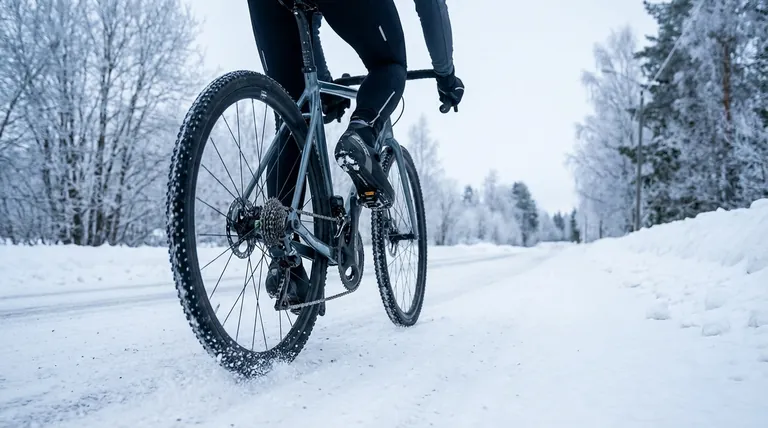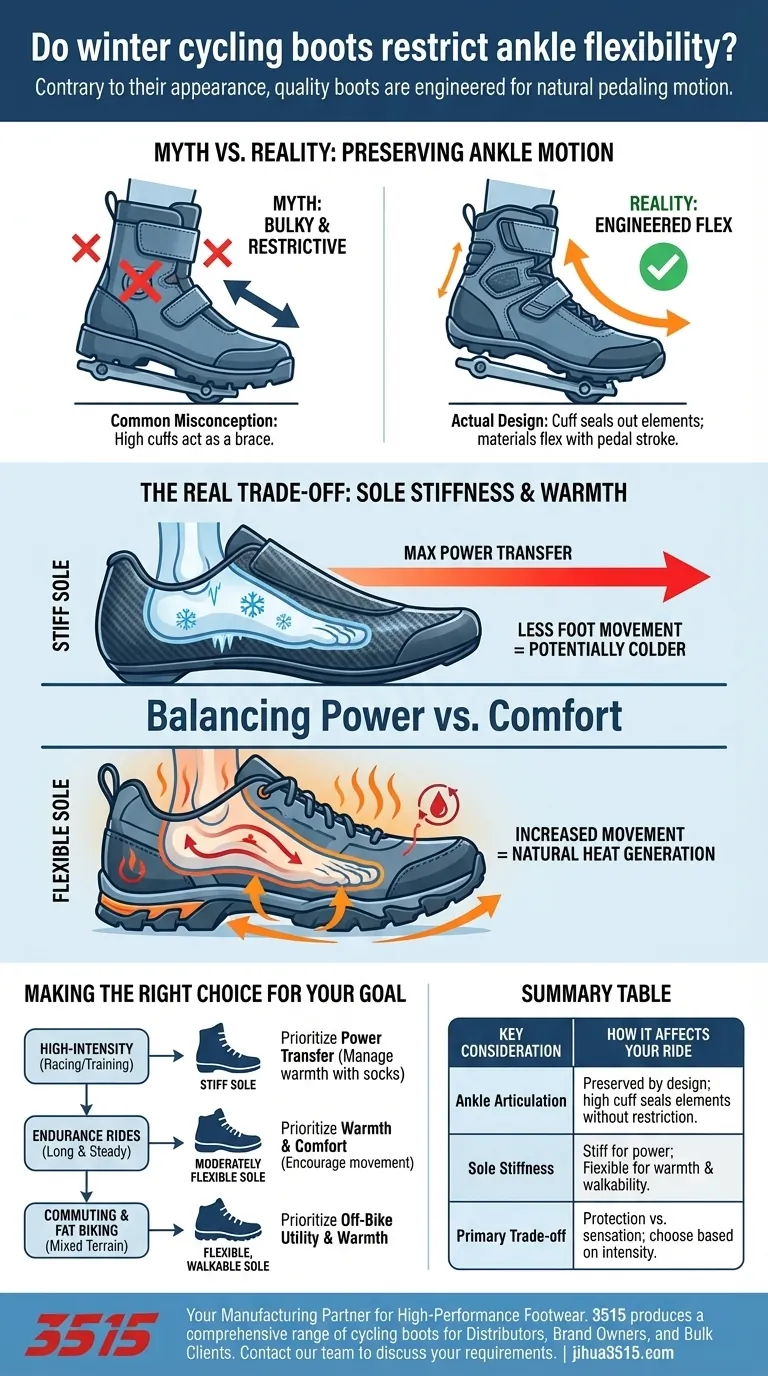Contrary to their bulky appearance, a quality pair of winter cycling boots is engineered to preserve the natural ankle flexibility required for an efficient pedal stroke. Most riders find that the boots do not feel clumsy or restrictive, allowing for a completely normal range of motion while cycling.
The core design principle of winter cycling boots is to add insulation and weather protection without compromising the essential articulation of the ankle. The factor you're more likely to notice is not ankle restriction, but the trade-off between sole stiffness for power and sole flexibility for warmth.

How Winter Boots Preserve Ankle Motion
The primary concern with any high-cuffed footwear is whether it will impede the movement necessary for the activity. Cycling boot manufacturers address this directly in their designs.
Engineered for the Pedal Stroke
Winter boots are built around the specific, repetitive motion of pedaling. The materials and construction around the ankle joint are intentionally designed to flex forward and backward with your foot, ensuring your pedaling mechanics are not compromised.
The Role of the Cuff
The high cuff on a winter boot serves one primary purpose: to seal out wind, water, and snow. It acts as a protective gasket, not a supportive brace. This section is typically made from flexible, waterproof materials like neoprene that move with you.
The Real Variable: Sole Stiffness and Warmth
While your ankle will move freely, the stiffness of the boot's sole is a critical design choice that has a significant impact on both performance and comfort in the cold.
Why Stiff Soles Can Lead to Colder Feet
Extremely stiff, performance-oriented soles are excellent for power transfer but can contribute to colder feet. They lock your foot into a rigid position, restricting the small muscle movements and flexions that naturally generate heat.
The Benefit of Strategic Flex
A boot with a slightly more flexible sole allows for more natural foot movement, both on and off the bike. This increased muscle activity inside the boot stimulates blood flow and helps your feet generate their own warmth, often making them more comfortable on long, cold rides.
Understanding the Trade-offs
Choosing the right winter boot involves balancing competing priorities. There is no single "best" boot, only the best boot for a specific type of riding and condition.
Protection vs. Sensation
You are trading the minimalist feel of a summer shoe for significant thermal and waterproof protection. While pedaling motion is unaffected, the boot will feel larger and more substantial on your foot.
On-Bike vs. Off-Bike Feel
Winter cycling boots are optimized for the bike. While a more flexible sole improves warmth and walking comfort compared to a rigid carbon race sole, they are still fundamentally cycling shoes and are not designed for extended walking.
Making the Right Choice for Your Goal
Select your winter footwear by focusing on your primary need for a given ride.
- If your primary focus is high-intensity training or racing in the cold: Choose a boot with a stiffer sole for maximum power transfer, and manage warmth with appropriate socks.
- If your primary focus is warmth and comfort on long endurance rides: Prioritize a boot with a moderately flexible sole to encourage foot movement and natural heat generation.
- If your primary focus is commuting or fat biking with hike-a-bike sections: A boot with a more flexible, walkable sole is the ideal choice for its blend of on-bike performance and off-bike utility.
By understanding that ankle motion is preserved by design, you can confidently focus on sole stiffness to find the perfect boot for your winter riding needs.
Summary Table:
| Key Consideration | How It Affects Your Ride |
|---|---|
| Ankle Articulation | Preserved by design; high cuff seals out elements without restricting motion. |
| Sole Stiffness | Stiff soles maximize power transfer; flexible soles aid warmth and off-bike comfort. |
| Primary Trade-off | Protection vs. sensation; choose based on ride intensity and conditions. |
Find Your Perfect Winter Cycling Boot
As a large-scale manufacturer, 3515 produces a comprehensive range of high-performance footwear for distributors, brand owners, and bulk clients. Our production capabilities encompass all types of cycling boots, engineered to master the balance of weather protection, warmth, and unrestricted movement.
Let us help you equip your customers for winter:
- For Distributors & Brand Owners: Access a reliable supply of boots designed for various riding disciplines, from intense training to comfortable commuting.
- For Bulk Clients: Get durable, purpose-built footwear for your team or organization, tailored to your specific needs.
Contact our team today to discuss your winter cycling footwear requirements and discover how 3515 can be your trusted manufacturing partner.
Visual Guide

Related Products
- Safety Footwear Wholesale Manufacturer for Custom OEM/ODM Production
- High Performance Fire-Retardant Waterproof Safety Boots
- Premium High-Cut Waterproof Safety Boots Manufacturing & Wholesale Solutions
- Factory-Direct Wholesale Canvas Boots with High-Traction Rubber Soles
- Factory Direct Wholesale Rain Boots Durable Waterproof & Fully Customizable
People Also Ask
- What cultural and environmental considerations are tied to wearing shoes indoors? Balance Hygiene, Tradition, and Foot Health
- What are the cultural perspectives on wearing shoes in the house? A Guide to Home Etiquette & Hygiene
- How long can you wear safety boots? The Lifespan is Determined by Wear, Not Time
- What are OSHA approved shoes? Understanding the Correct Standards for Workplace Safety
- How do safety shoes contribute to cost savings for companies? A Strategic Investment in Risk and Cost Management



















